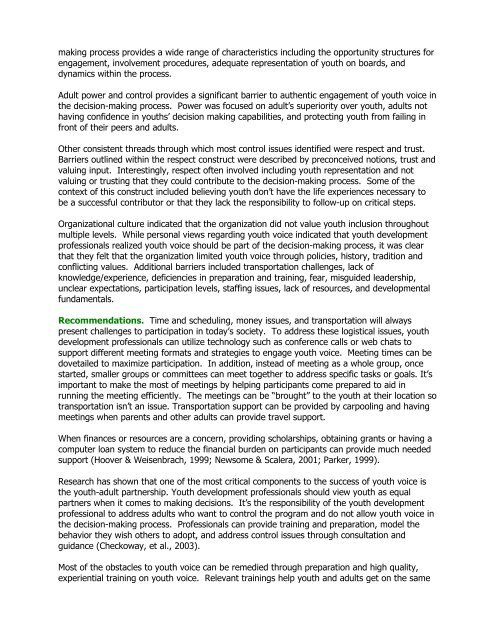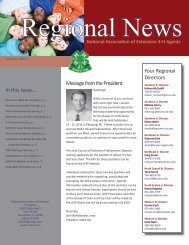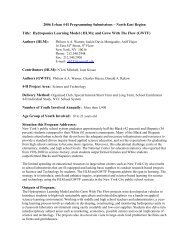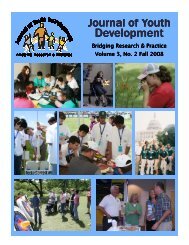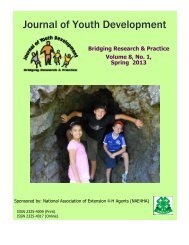Winter 2008 - Vol. 3 No. 3 - National Association of Extension 4-H ...
Winter 2008 - Vol. 3 No. 3 - National Association of Extension 4-H ...
Winter 2008 - Vol. 3 No. 3 - National Association of Extension 4-H ...
- No tags were found...
You also want an ePaper? Increase the reach of your titles
YUMPU automatically turns print PDFs into web optimized ePapers that Google loves.
making process provides a wide range <strong>of</strong> characteristics including the opportunity structures forengagement, involvement procedures, adequate representation <strong>of</strong> youth on boards, anddynamics within the process.Adult power and control provides a significant barrier to authentic engagement <strong>of</strong> youth voice inthe decision-making process. Power was focused on adult’s superiority over youth, adults nothaving confidence in youths’ decision making capabilities, and protecting youth from failing infront <strong>of</strong> their peers and adults.Other consistent threads through which most control issues identified were respect and trust.Barriers outlined within the respect construct were described by preconceived notions, trust andvaluing input. Interestingly, respect <strong>of</strong>ten involved including youth representation and notvaluing or trusting that they could contribute to the decision-making process. Some <strong>of</strong> thecontext <strong>of</strong> this construct included believing youth don’t have the life experiences necessary tobe a successful contributor or that they lack the responsibility to follow-up on critical steps.Organizational culture indicated that the organization did not value youth inclusion throughoutmultiple levels. While personal views regarding youth voice indicated that youth developmentpr<strong>of</strong>essionals realized youth voice should be part <strong>of</strong> the decision-making process, it was clearthat they felt that the organization limited youth voice through policies, history, tradition andconflicting values. Additional barriers included transportation challenges, lack <strong>of</strong>knowledge/experience, deficiencies in preparation and training, fear, misguided leadership,unclear expectations, participation levels, staffing issues, lack <strong>of</strong> resources, and developmentalfundamentals.Recommendations. Time and scheduling, money issues, and transportation will alwayspresent challenges to participation in today’s society. To address these logistical issues, youthdevelopment pr<strong>of</strong>essionals can utilize technology such as conference calls or web chats tosupport different meeting formats and strategies to engage youth voice. Meeting times can bedovetailed to maximize participation. In addition, instead <strong>of</strong> meeting as a whole group, oncestarted, smaller groups or committees can meet together to address specific tasks or goals. It’simportant to make the most <strong>of</strong> meetings by helping participants come prepared to aid inrunning the meeting efficiently. The meetings can be “brought” to the youth at their location sotransportation isn’t an issue. Transportation support can be provided by carpooling and havingmeetings when parents and other adults can provide travel support.When finances or resources are a concern, providing scholarships, obtaining grants or having acomputer loan system to reduce the financial burden on participants can provide much neededsupport (Hoover & Weisenbrach, 1999; Newsome & Scalera, 2001; Parker, 1999).Research has shown that one <strong>of</strong> the most critical components to the success <strong>of</strong> youth voice isthe youth-adult partnership. Youth development pr<strong>of</strong>essionals should view youth as equalpartners when it comes to making decisions. It’s the responsibility <strong>of</strong> the youth developmentpr<strong>of</strong>essional to address adults who want to control the program and do not allow youth voice inthe decision-making process. Pr<strong>of</strong>essionals can provide training and preparation, model thebehavior they wish others to adopt, and address control issues through consultation andguidance (Checkoway, et al., 2003).Most <strong>of</strong> the obstacles to youth voice can be remedied through preparation and high quality,experiential training on youth voice. Relevant trainings help youth and adults get on the same


